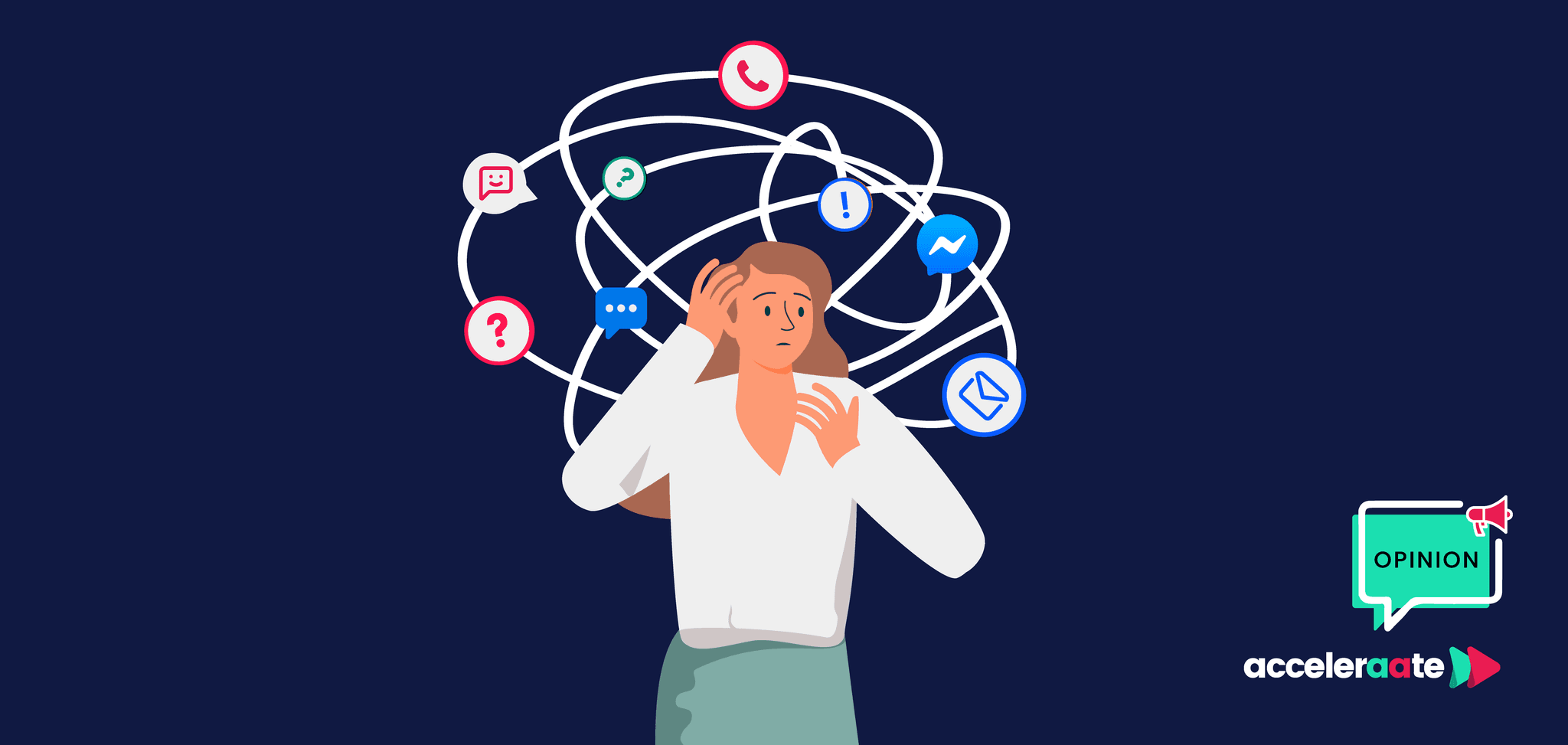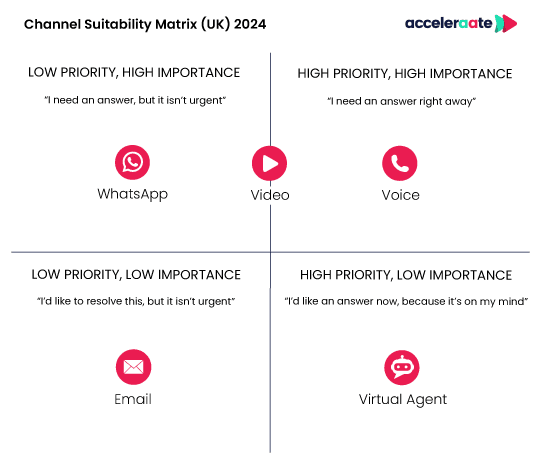
One of the requirements we regularly encounter during contact centre procurement processes and RFPs is the ability to support multiple contact channels (omnichannel) and – today – the list of these channels is vast: Voice, Video, Web Chat, App Chat, Email, SMS, Facebook, Instagram, X, WhatsApp, WeChat, Apple Business Chat, and more.
If we’re going to be a little conspiratorial, there may be a train of thought that this explosion in contact channels has been mostly driven by CCaaS vendors, looking for new opportunities to upsell licenses. But did anybody actually ask the consumer how they would like to engage? Or did we all just assume that more channels = more choice = better experience?
A common challenge when planning to extend the choice of contact channels is that - in our experience - it’s often not the right thing to do. This is not always the case of course, especially if you only offer one or two contact channels right now, but in the main simply adding new ones can cause more problems than it solves, and sometimes creates even more contact for your team to manage. And don’t forget about the additional training and re-skilling that is generally required as well!
Another challenge is that successfully embracing and adopting new channels requires a change in your customers’ behaviour. This is sometimes referred to as a channel shift strategy, and it is much more difficult to achieve than you might think, because changing your customers’ behaviour can take a very long time (some will even resist the change), and you may ultimately need to force it to happen – which can lead to negative feedback and reviews.
Recent UK research shows that inbound customer service interactions currently break down (on average) as follows:
Voice (63%)
Email/Webform (17%)
Web chat (8%)
Social media (4%)
This means that today, voice and email still represent 80% of inbound contact to customer service/contact centres. This is expected to be at 76% in 2026 so it is declining, but not at the rate of knots we might have anticipated.
So, is expanding the choice of contact channels really the answer? Or should we be looking to re-think and optimise the channels that we and our customers already use, know, and trust?
This is something that we’ve been reflecting on recently, and we have a theory about why the digital channels (the ones that most contact centre procurement processes are currently insisting upon) have not seen the level of adoption that we might have predicted five years ago.
And here it is…
Some digital channels simply don't work all that well for customer service.
Controversial? We don’t think so! Here’s why…
All contact channels have their strengths and weaknesses but, in our experience, some are significantly weaker than others. To illustrate this point, we’ve created a matrix plotting two of the most important elements to consider when selecting contact channels – Trust, and Convenience:

How the matrix works.
Trust
This reflects to what extent a consumer feels comfortable engaging with an organisation over a particular channel. To plot this, we have considered elements such as to what extent a consumer would be comfortable divulging personally identifiable information, and how consumers perceive their ability to achieve a satisfactory resolution through that channel. There is also an element of trust that can be linked to the reputation of the technology provider: For example:
Phone – 98% of the UK adult population have a mobile phone = high trust.
Email – 85% of the UK adult population sends or receives email weekly = high trust.
X (Twitter) – potentially tarnished by consumers' perception of the company behind the technology - lower trust.
WhatsApp - used by consumers day-to-day to communicate with friends, family, and in business - high trust.
Convenience
This reflects to what extent a contact channel is convenient for the consumer. To plot this, we have considered – to what extent consumers have already adopted the channel, and how much effort is involved in achieving a resolution through that channel. One element of this thought process is considering the synchronicity of the channel: Does the consumer need to wait in real-time for the answer (synchronous), or can the consumer get on with other things whilst they wait for a response (asynchronous). For example:
Live chat – Synchronous channel. The consumer generally needs to wait on the webpage with the chat widget open to ensure the conversation isn’t lost or times-out (inconvenient for the consumer).
Email – Asynchronous channel. Consumers do not expect an immediate response; therefore, contact can be managed more methodically and more predictably.
(Of course, an element of this will always be subjective, and the suitability of certain channels does of course depend on several other factors including industry, regulation, law, and audience demographic. And if you disagree with our rationale, that’s absolutely fine. Feel free to let us know why!)
The future of customer service contact channels – our prediction.
We envisage that contact centre and customer service operators will ultimately consolidate their channels as follows:
Voice - For high value/more complex enquiries with a human touch, supported by appropriate automation (for example ID&V, intent detection, IVR self-service).
Video - For high value/more complex enquiries where the most personal experience is required, supported by appropriate automation. Video is particularly relevant to Gen Z consumers who have been brought up with video calls and use video as a primary communication method.
Email/ Webform - For higher volume/lower value enquiries, or matters requiring follow-up. Complemented by Automation/Virtual Agent to encourage self-service before handing over to a human and/or ticketing system.
WhatsApp/ Apple Messaging/ We Chat/ Facebook Messenger (depending on geography) - For higher volume/lower value enquiries. Assisted by Automation/Virtual Agent to encourage self-service before handing over to a human (if needed).
Channel application & suitability.
Based on the nature of the contact reason (intent), we envisage the channels of the future being deployed as illustrated in the diagram below. You will note that we have included Virtual Agent in this matrix – as we consider that all channels will be complemented and enhanced by AI & Automation to ensure optimal efficiency. And unmanned Virtual Agents have become a very effective way to deliver self-service answers when consumers need them.

Why isn’t Live chat on the list?
Interestingly, in recent years we’ve seen more and more customers switching off their Live chat channel. And we believe that this is because Live chat brings with it some fundamental problems:
Live chat is a synchronous channel and needs to be manned to work effectively. Otherwise, customers just become frustrated (quickly). And when a customer engages in a Live chat discussion on a desktop computer, they usually have to wait on the same page of your website for a response – this prevents them from doing other things whilst they’re waiting. In fact, per Kayako, almost a fifth of consumers rate long wait times as the most frustrating part of a Live chat — they don't want to be in a queue. Most consumers refuse to wait more than five minutes for a response.
Live chat suffers from a low trust reputation with many consumers, and this is partly due to the plethora of "poor" chat and chatbot experiences out there which cause consumer frustration. It is of course possible to create brilliant, helpful, and efficient chatbot experiences using modern tools such as Zoom Virtual Agent, but it can be a difficult channel to get right. It's a bit like when Skype launched as the original mainstream VoIP solution in 2003. Frankly, it wasn't very good, and it gave VoIP a poor reputation for a number of years. Of course, VoIP has now become the norm for voice, so you never know... Live chat might get there eventually!
Live chat can also be very time-consuming. It’s true… in the majority of cases it would have been quicker and more efficient to make the phone call.
Why WhatsApp, specifically?
Two simple reasons:
WhatsApp is pretty much ubiquitous in the UK with 73.4% of internet users aged 16 to 64 chatting on it. WhatsApp gives you access to one of the widest audiences available, across almost all age groups. Think about your own colleagues, friends, and family: How many of them are using WhatsApp? We would guess most, if not all of them.
WhatsApp is very convenient. We’ve already established that a majority of people in the UK already have the app on their phone, and it’s probably in everyday use. But what makes it most convenient is that fact it’s a genuinely asynchronous contact channel – because your customers can send a message, and then put their phone down (and even lock it) without fear of the conversation timing-out, or missing the response. WhatsApp is supported by many of the major cloud CCaaS providers such as Amazon Connect and Zoom Contact Center.
Note, for other geographies outside of the UK and Europe, we simply replace WhatsApp with the most broadly adopted messaging platform (for example, Apple Messaging of Facebook Messenger in the US, WeChat in China, etc.)
I thought Voice was dying in contact centres?
Just under three-quarters of the interactions between customers and support agents still occur over the phone, and in our opinion there will always be a place for voice in customer service. The human touch is far too important in delivering experiences that customers love, for consumers to turn their back on what was the original contact channel. Voice is extremely accessible, as dialling a phone number is a universal contact method that people of all generations understand. Offering phone support shows consumers that you want them to be able to deal with you in a way that is comfortable, trusted, and convenient for them.
Video? That’s a new one!
Whilst still considered by many as a “new” approach to customer service, we see multiple benefits and use cases for video. Video is the enabler for new customer context, and highly personal allowing organisations to make direct connections with customers, building trust and ownership. It also provides the opportunity to resolve complex problems visually.
For example, in recent times we have seen video used by Local Councils to assess citizens for benefit claims, used by Utilities companies to gather important visual context for water leaks, and used by Housing Associations to help resolve maintenance problems for tenants in real-time. Perhaps unsurprisingly (and no doubt accelerated by the pandemic) video is already mainstream in healthcare for tele-health, and post-appointment interactions, with Zoom Phone and Zoom Contact Center leading the way for the provision of video-optimised customer and patient experiences. In short, video can help to speed up resolution times, and provide a second-to-none, personal service.
We can potentially see a future where video actually overtakes voice in customer service, particularly when considering Gen Z's adoption of video as a preferred communication channel, and the emerging Gen Alpha who will be our next generation of consumers in the next couple of years.
Isn’t Email/Webform outdated now?
As we established earlier in this article, email remains the second most adopted contact channel for customer service in the UK, and for good reason. When managed and deployed well, email provides a trusted, ubiquitous, and asynchronous contact channel that works well for consumers in most age groups.
We see a future where email and webform contact is assisted by a Virtual Agent, gathering context, identifying and verifying the consumer, and providing simple self-service capabilities. In the event a human agent is then required to close the enquiry, modern Virtual Agent solutions such as Zoom Virtual Agent allow seamless, contextual hand-off to an email address or ticketing system such as Zendesk, Salesforce, ServiceNow, and Gorgias. This delivers a very efficient way to manage email contact, whilst keeping humans in the loop when they're needed.
In Summary.
In our experience most organisations think they need to add more contact channels because that is what they believe consumers want.
But, do they? And do they actually benefit from more choice?
Right now, a broad omnichannel service strategy is very fashionable, but it may not be delivering optimal benefits for both consumers and organisations. In fact, there's a very real possibility that too much choice is starting to affect how much consumers engage with brands, and that they may then face "choice paralysis" when it comes to obtaining customer service.
We believe that now is the time for organisations to re-think their customer service channels, considering the elements of Trust, Convenience, and Suitability as described above, and assessing what the provision of additional choice is doing to their ability to deliver the best possible customer experience.
What are your thoughts on this topic? We’d love to hear from you.
Why work with Acceleraate?
We are a UK-based boutique digital CX specialist, delivering customer experience and customer service transformation and optimisation. We focus on solving problems by uniting cloud technology with smart and straightforward thinking. With over 20 years of hands-on experience designing, implementing, and managing cloud contact centres and AI solutions for some of the UK's best-known businesses and brands, Acceleraate delivers CX strategy, system integration, optimisation, software development, and managed services for business.
Need some help assessing and optimising your contact channels?
About the author

Part of Founded Group Limited








